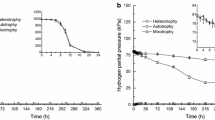Summary
Submerged cultures of Str. rimosus excrete pyruvic and α-oxoglutaric acid in glucose-containing mediums in the presence of casaminoacids. After buffering with carbonates the amounts of keto acids increase about threefold.
N-free cultures show smaller amounts of keto acids, but after 24 h we can see an antagonistic behaviour of both curves: pyruvic acid is converted stoichiometrically to oxoglutaric acid.
Succinate and α-oxoglutarate delay the secondary reception of pyruvate without changes in primary excretion.
Replacement of glucose by glycerine-containing cultures shows that pyruvate excretion is not due to a glucose-effect in the sense of enzyme-repression.
NH4-ions depress, pyruvate-excretion and induce a very good growth. A NH4-dependent pyruvate peak appears only in the presence of succinate.
The excretion of keto acids by Streptomycetes is caused by two unequal metabolic disturbances: the initially inhibited pyruvate-oxidation with failed pyruvate dehydrogenase, and the associated competition from pyruvate and/or α-oxoglutarate oxidation based on a previously formulated regulation principle.
Zusammenfassung
Submerskulturen von Streptomyces rimosus scheiden auf glucosehaltigen Medien in Gegenwart von Casaminoazids Pyruvat und α-Ketoglutarat aus, deren Konzentration durch Zugabe von puffernden Carbonaten erheblich erhöht werden kann.
N-freie Versuchsansätze enthalten geringere Ketosäuremengen, zeigen jedoch innerhalb der späteren Entwicklungsabschnitte ein antagonistisches Verhalten von Pyruvat und α-Ketoglutarat. Von der 24. Std bildet sich α-Ketoglutarat unter Abnahme des ausgeschiedenen Pyruvates. Die Umbildung erfolgt stöchiometrisch.
Zusätze von Succinat oder α-Ketoglutarat verzögern lediglich die Wiederaufnahme der extracellularen Brenztraubensäure, sie beeinflussen nicht die Anstiegswerte der Pyruvatbildung.
Versuchsansätze mit Glycerin anstelle von Glucose zeigen, daß die Pyruvatstauung keinem Glucoseeffekt im Sinne spezieller Enzymrepressionen zugeordnet werden kann.
Aus den Ergebnissen der NH4 .-Versuche geht hervor, daß Wachstumsvorgänge und Pyruvatstauung Antagonisten sind. Eine NH4 .-bedingte Pyruvatanhäufung erfolgt nur bei Anwesenheit von Succinat.
Die Ketosäureausscheidung der Streptomyceten wird auf zwei ungleiche Stoffwechselstörungen zurückgeführt: die anfängliche gehemmte Pyruvatoxydation und die anschließende Konkurrenzbeziehung der Pyruvat-bzw. α-Ketoglutaratoxydation auf der Basis eines früher formulierten Kontrollprinzipes.
Similar content being viewed by others
Literatur
Bormann, E. J.: Stoffwechselregulation, und Brenztraubensäurestauung bei Antibiotica-bildenden Streptomyceten. Arch. Mikrobiol. 53, 218 (1966).
—, u. M. Wentzke: Periodische Atmungsschwankungen bei Str. rimosus und ihre Beziehungen zum NH4-Stoffwechsel. Z. Naturforsch. 22b, 436 (1967).
Bowman, R. H.: Effects of diabetes, fattyacids and ketone bodies on TCC-metabolism in the perfused rat heart. J. biol Chem. 241, 3041 (1966).
Chen, R. F., and G. W. E. Plaut: Activation and inhibition of DPN-linked Isocitratdehydrogenase on heart by certain nucleotides. Biochemistry 2, 1023 (1963).
Friedemann, T. E., and G. E. Haugen: Pyruvic acid III. The determination of ketoacids in blood and urine. J. biol. Chem. 147, 514 (1943).
Garland, P. B., P. J. Randle, and E. A. Newsholme: Citrate as an intermediary in the inhibition of phosphofrucrokinase in rat heart muscle by fatty acids, ketone bodies, pyruvate, diabetes and starvation. Nature (Lond.) 200, 169 (1963).
Goldberg, N. D., J. V. Passonneau, and D. H. Lowry: Effects of changes in brain metabolism on the levels of citric acid cycle intermediates. J. biol. Chem. 241, 3997 (1966).
Hanson, R. S., and D. P. Cox: Effect of different nutritional conditions on the synthesis of TCC-enzymes. J. Bact. 93, 1777 (1967).
Haslam, R. J., and H. A. Krebs: Competitive inhibition of substrates in respiration of animal tissue. Biochem. J. 86, 432 (1963).
Henning, U.: Multienzymkomplexe. Angew. Chem. 78, 865 (1966).
—, G. Dennert, u. G. Deppe: Zur Regulation der Synthese des P Pyruvatdehydrogenasekomplexes in E. Coli K 12. studia, biophysica, S2, 145 (1966).
Holzer, H.: Intracelluläre Regulation des Stoffwechsels. Naturwissenschaften 50, 260 (1963).
Hülsmann, W. C., D. Silipandri, C. Ciman, and N. Silipandri: Effects of carnithine on the oxydation of α-ketoglutarat to succinate in the presence of acetooctonate and pyruvate. Biochim. biophys. Acta (Amst.) 93, 106 (1964).
Kosicki, G. W., and L. P. K. Lee: Effect of divalent metal ions on nucleotide inhibition of pig heart citrate synthetase. J. biol. Chem. 241, 3571 (1966).
Krebs, H. A.: Control of metabolism. Exp. Eye Res. 1, 350 (1962).
—: The equilibirum constants of the fumarase and aconitase. Biochem. J. 54, 78 (1953).
Lehninger, A. L.: Supramolecular organisation of enzyme and membrane systems. Naturwissenschaften 53, 57 (1966).
Lowry, D. H., N. J. Rosebrough, A. L. Farr and R. J. Randall: J. biol. Chem. 193, 265 (1951), Zit. in: Keil, B., u. Z. Sormova: Laboratoriumstechnik für Biochemiker. Leipzig: Akademieverlag 1965.
Polakis, E. S., and W. Bartley: Changes in enzyme activities of Saccharomyces cerevisiae in response to changes in the environment Biochem. J. 97, 284 (1965).
Qualiariello, E., S. Papa, C. Saccone, F. Palmieri and A.Francavilla: The control mechanism of glutamatdehydrogenase in rat liver mitochondria and the effect of inhibitors and several substances of respiration on the desamination of glutamate. G. Biochem. 14, 44 (1965).
Schäfer, G., P. Balde, and W. Lamprecht: Substrate transformations dependent on respiratory states of mitochondria. Nature (Lond.) 214, 20 (1967).
Takeda, H., S. Tadayoshi, and S. Tsuiki: Effect of dinitrophenol on the oxydation of pyruvate in Ehrlich-Ascites-Tumore-Cells. Biochem. biophys. Res. Commun. 29, 90 (1967).
Vagelos, P. R., A. W. Alberts, and D. B. Martin: Studies on the mechanism of activation of Acetyl-Coencyme-A Carboxylase by citrate. J. biol. Chem. 238, 533 (1963).
Wieland, O., L. Weiss, J. Eger-Neufeld, A. Teinzer u. B. Westermann: Coenzym A-Thioester höherer Fettsäuren als mögliche Vermittler enzymatischer Reaktionen im Tierkörper. Klin. Wschr. 43, 654 (1965).
Wright, J. A., P. Maeba, and B. D. Sanwal: Allostaric regulation of the activity of citrate synthetase of E. coli by α-ketoglutarate. Biochem. biophys. Res. Commun. 29, 34 (1967).
Author information
Authors and Affiliations
Rights and permissions
About this article
Cite this article
Bormann, EJ., Herrmann, R. Zur Pyruvat- und α-Ketoglutaratausscheidung durch Streptomyces rimosus . Archiv. Mikrobiol. 63, 41–52 (1968). https://doi.org/10.1007/BF00407063
Received:
Issue Date:
DOI: https://doi.org/10.1007/BF00407063




